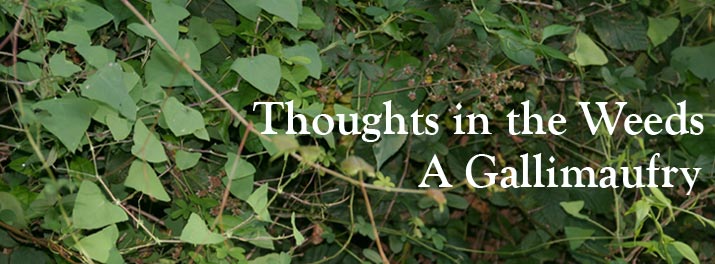When I first started weeding, I hardly knew what was a weed and what was not. I could identify roses and daffodils, tulips, day lilies, lily of the valley, and a few more, but not a whole lot more.
As I watched the landscape over the spring and summer, things popped up, proliferated, and came back the next year. I was cautious. I knew that 100 years ago, the land was farmed and managed by a great aunt who really knew her stuff when it came to wildflowers and other plants. So, like hunting for a long lost Declaration of Independence hidden in the back of a drawer, I searched the landscape for extraordinary plants.
Since I spend so much time weeding, I thought I’d offer some random advice.
Know Your Weeds
There are many books and web sites that identify weeds. I’ve found “Invasive Plants of the Eastern United States” particularly helpful for the real thugs. Of course, it helps to know the name of what you’re looking for so that you can find a photo of the plant to compare with what you have. But most books and websites have photos that you can browse through. The advice of experienced gardeners, who are almost universally generous, is invaluable.
Pay Attention
It’s easy to get carried away. You’re busily pulling some vine or other, the mind wanders, and all of a sudden, you’re elbow deep in poison ivy or you’ve yanked something that you paid a fortune for a few years ago at the garden store and forgot about.
Go Out Early in the Morning
Before the heat of the day and preferably after a rain. Weeds are easier to pull from moist soil than from dry, baked ground. Follow the sun, or rather the shade, in summer.
Be Prepared
There will be bugs — mosquitoes and midges. I put on a Bert’s Bees anti-insect concoction, which seems to help. I also wear long pants, socks, boots, and a long-sleeved shirt (usually with the sleeves rolled up) when I’m doing heavy weeding in the field and woodland beyond the lawn. I know, it’s hot. But it’s protection against insects and prickles. I only wear gloves when I’m dealing with thorns, poison ivy, or mile-a-minute vine. I can't feel the plants and roots with gloves on.
Water, Water, Water
I mean drink it yourself. No need to say more.
On Compulsivity
Yes, you can just weed-wack weeds. But they will come back. Some are masochists and love being weed-wacked. I pull as much as I can, to get the roots. Pull slowly and carefully, otherwise, the stem may break and the root will still be there, ready to continue growing when your back is turned. Get them early, the more mature they are, the harder it is to get all the roots. In plants with rhizomes, it's impossible.
Prioritize
I will never get rid of all the weeds in my landscape and neither will you. They're hardy and determined, which is why they've persisted for so long. But there are some, the thugs that crowd out everything else,and the strangle vines, that have my attention. I will certainly never eradicate fiveleafed akebia or Japanese honeysuckle. But each year I have a goal to push them back further, starting from the edges, and, of course, rescuing rhododendrons, laurel, and any other legitimate plant from their clutching tendrils.
After Work
I always take a thorough shower, even if it’s cool and I haven’t gotten sweaty or muddy. I also examine my body as thoroughly as I can. We have a substantial resident deer population that brings with it deer ticks, carriers of Lyme Disease. I’ve had it twice and it’s not fun. Vigilance — and I mean vigilance, dear ticks are distinguishable from a speck of dirt only with a magnifying glass — helps.
Above All, Enjoy
Yes, it’s work, but satisfying work, good for the body, good for the soul. A great stress reliever and workout. Don't kill yourself. Stop while you still have time to sit back and enjoy. And so it won't hurt as much the next morning.













